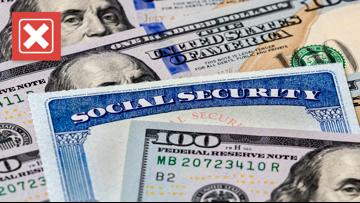UPDATE: On Oct. 13, 2022, the Social Security Administration announced that its 2023 cost-of-living adjustment (COLA) will be 8.7%, the highest since 1981. The latest information is available here. The original story continues as published below:
In 2022, Social Security and Supplemental Security Income (SSI) recipients saw a 5.9% increase to their benefits, the largest since 1982, due to an annual cost-of-living adjustment based on inflation rates.
Social Security provides people with an income when they retire or can’t work due to disability. Those who are retired can typically start receiving their Social Security benefits as early as age 62.
In recent weeks, some people on social media have claimed that Social Security payments will increase as much as 10% in 2023.
Ruby and other VERIFY readers also asked the team if Social Security recipients will see a bigger increase than normal in their checks next year.
THE QUESTION
Is the Social Security cost-of-living adjustment for 2023 expected to be higher than average?
THE SOURCES
- Social Security Administration (SSA)
- U.S. Bureau of Labor Statistics
- Mary Johnson, Social Security and Medicare policy analyst for The Senior Citizens League
- AARP
THE ANSWER
Yes, the Social Security cost-of-living adjustment for 2023 is expected to be higher than average.
WHAT WE FOUND
The Social Security Administration (SSA) adjusts benefit amounts every year to account for inflation through a cost-of-living adjustment (COLA). SSA is expected to announce the 2023 COLA on Thursday, Oct. 13.
The COLA is calculated based on the percentage increase in the Consumer Price Index for Urban Wage Earners and Clerical Workers (CPI-W), an inflation gauge measured by the U.S. Bureau of Labor Statistics (BLS). It measures the average change over time in the prices that workers are paying in a “basket of consumer goods and services.”
The SSA explains on its website that the COLA is equal to the percentage increase in the CPI-W from the third quarter average of the previous year to the same average from the current year. If there is an increase, it’s rounded to the nearest tenth of a percent. That same increase is applied to monthly Social Security payments.
More from VERIFY: No, Social Security recipients aren’t getting new $1,400 stimulus checks
To determine the COLA for 2023, SSA will compare the CPI-W for July, August and September of 2021 to the same period in 2022.
In July 2022, the CPI-W increased 9.1% annually, BLS data show. It dipped slightly to 8.7% annually in August 2022. Data for September has not been released yet.
Data from SSA show that the highest COLA on record was 14.3% in 1980. But, over the past decade, the COLA has averaged just below 2%.
More recently, it increased from 1.3% in 2021 to 5.9% in 2022. The last time the COLA was close to this percentage increase was in 2009, when it was 5.8%.
Though SSA hasn’t yet announced the COLA for 2023, experts estimate that benefits could increase by the largest amount since 1981. The COLA was 11.2% that year.
Mary Johnson, the Social Security and Medicare policy analyst for the Senior Citizens League, predicted in September that the COLA will be 8.7% in 2023, a decrease of nearly a full percentage point from her estimate one month prior. That would average out to about $144 more per month for retired workers.
“A COLA of 8.7% is extremely rare and would be the highest ever received by most Social Security beneficiaries alive today. There were only three other times since the start of automatic adjustments that it was higher,” Johnson said.
David Certner, legislative counsel and director of legislative policy for government affairs at AARP, estimated in August that Social Security recipients could expect a 2023 COLA in the 8-10% range.
COLAs for the SSI program, which provides monthly payments to adults and children with a disability who have limited incomes and resources, are generally the same as those for Social Security, though they usually take effect the month after Social Security benefit increases, SSA says on its website.












